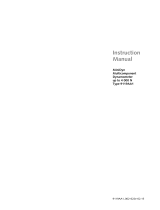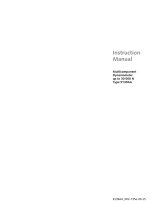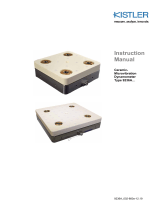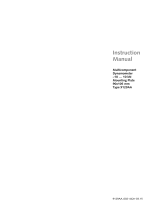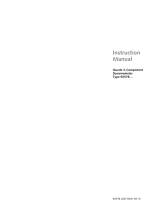Page is loading ...

Instruction
Manual
MicroDyn
Mehrkomponenten-
Dynamometer bis
500 N
Typ 9109AA
9109AA_002-827e-06.18
MicroDyn
Multicomponent
Dynamometer
up to 500 N
Type 9109AA1

Instruction
Manual
MicroDyn
Mehrkomponenten-
Dynamometer bis
500 N
Typ 9109AA
9109AA_002-827e-06.18
MicroDyn
Multicomponent
Dynamometer
up to 500 N
Type 9109AA1


Foreword
9109AA_002-827d-06.18 Page 1
Foreword
Thank you for choosing a Kistler quality product charac-
terized by technical innovation, precision and long life.
Information in this document is subject to change without
notice. Kistler reserves the right to change or improve its
products and make changes in the content without
obligation to notify any person or organization of such
changes or improvements.
© 2018 Kistler Group. Kistler Group products are
protected by various intellectual property rights. For more
details visit www.kistler.com. The Kistler Group includes
Kistler Holding AG and all its subsidiaries in Europe,
Asia, the Americas and Australia.
Kistler Group
Eulachstrasse 22
8408 Winterthur
Switzerland
Tel. +41 52 224 11 11
www.kistler.com

MicroDyn Multicomponent Dynamometer up to 500 N, Type 9109AA1
Page 2 9109AA_002-827d-06.18
Contents
1.Introduction .................................................................................................................................. 4
2.Important information ................................................................................................................. 5
2.1For your safety .................................................................................................................... 5
2.2Hints for handling this device .............................................................................................. 6
2.3Tips on using the instruction manual .................................................................................. 7
2.4What happens when there are changes? .............................................................................. 7
3.General device description ........................................................................................................ 8
3.1What is a Multicomponent Dynamometer used for? ........................................................... 8
3.2Functional principle ............................................................................................................. 9
3.3Dynamometer construction ............................................................................................... 10
4.Mounting, installation and initial startup ................................................................................ 11
4.1Important information ........................................................................................................ 11
4.2Mounting the Dynamometer .............................................................................................. 12
4.3Basic connection and cabling of the measuring system ................................................... 15
4.4Dynamometer positioning ................................................................................................. 15
4.5Measuring system for 3- or 4-component measurement (Fx, Fy, Fz / Mz) .......................... 16
5.Operation .................................................................................................................................... 19
5.1Range selection ................................................................................................................ 19
5.2Measuring small changes in force .................................................................................... 19
5.3Useful frequency range ..................................................................................................... 21
5.4Piezoelectric force measurement ...................................................................................... 23
5.5Tips for better measuring results ...................................................................................... 26
5.6Measurement signal polarity ............................................................................................. 26
6.Maintenance ............................................................................................................................... 27
6.1Re-calibrating the device ................................................................................................... 27
6.2Maintenance work ............................................................................................................. 28
7.Fault elimination ........................................................................................................................ 29
7.1Troubleshooting ................................................................................................................ 29
7.2What to do if the Dynamometer is faulty ........................................................................... 30
8.Technical data............................................................................................................................ 31
8.1MicroDyn Type 9109AA .................................................................................................... 31
8.2Dimensions ....................................................................................................................... 32
9.Accessories ............................................................................................................................... 33
9.1Included accessories ......................................................................................................... 33
9.2Optional accessories ......................................................................................................... 33
10.Ordering code ............................................................................................................................ 35
11.Appendix .................................................................................................................................... 36
11.1Glossary ............................................................................................................................ 36
11.2Measurement Uncertainty ................................................................................................. 39

Introduction
9109AA_002-827d-06.18 Page 3
11.3Linearity ............................................................................................................................. 40
11.4Frequency Range .............................................................................................................. 42
11.5Temperature effect ............................................................................................................. 43
Total number of pages: 44

MicroDyn Multicomponent Dynamometer up to 500 N, Type 9109AA1
Page 4 9109AA_002-827d-06.18
1. Introduction
Please take the time to thoroughly read this instruction
manual. It will help you with the installation, maintenance,
and use of this product.
To the extent permitted by law Kistler does not accept
any liability if this instruction manual is not followed or
products other than those listed under Accessories are
used.
Kistler offers a wide range of products for use in
measuring technology:
Piezoelectric sensors for measuring force, torque,
strain, pressure, acceleration, shock, vibration and
acoustic-emission
Strain gage sensor systems for measuring force and
torque
Piezoresistive pressure sensors and transmitters
Signal conditioners, indicators and calibrators
Electronic control and monitoring systems as well as
software for specific measurement applications
Data transmission modules (telemetry)
Kistler also develops and produces measuring solutions
for the application fields engines, vehicles,
manufacturing, plastics and biomechanics sectors.
Our product and application brochures will provide you
with an overview of our product range. Detailed data
sheets are available for almost all products.
If you need additional help beyond what can be found
either on-line or in this manual, please contact Kistler's
extensive support organization.

Important information
9109AA_002-827d-06.18 Page 5
2. Important information
It is essential to follow the instructions below for your own
personal safety when working and to ensure long-lasting,
trouble-free operation of the device.
2.1 For your safety
This device has been thoroughly tested and was
perfectly safe when it left the factory. To keep it in this
condition and ensure risk-free operation, the user
must observe the information and warnings contained
in this Instruction Manual.
The dynamometer must only be installed, operated
and repaired by persons who are familiar with the
device and who are suitably qualified for their
particular work.
If you believe that the device can no longer be
operated without risk, it must be taken out of operation
and secured to prevent accidental operation.
You should believe that the device can no longer be
operated without risk,
if there are visible signs of damage on the device,
if the device is no longer working,
after prolonged storage under adverse conditions,
if mishandled during transportation.
When measuring the cutting force, fasten the
dynamometer to the machine tool as specified! Details
can be found in the 4.2 "Mounting the dynamometer"
chapter.
Fasten all the parts mounted on the cover plate of the
dynamometer in accordance with the forces that are
expected!

MicroDyn Multicomponent Dynamometer up to 500 N, Type 9109AA1
Page 6 9109AA_002-827d-06.18
2.2 Hints for handling this device
You must only work with the dynamometer in
specified environmental and operating conditions
Insulation resistance is crucial for piezoelectric
measurements; it must be about 100 T (but at least
10 T)
To obtain this value, all the plug connections must be
kept scrupulously clean and dry
The insulation resistance can be measured with a
Type 5493 insulation tester
Protect the device signal output against contamination
and do not touch it with your fingers. Put on the
supplied cover if the connection is not assigned
The connecting cable (connecting cable from the
dynamometer to the charge amplifier input) has high
insulation. Only specified connecting cables must be
used
The connecting cable should not be removed from the
dynamometer
When the dynamometer is not being used, keep it in
the supplied packing case to protect it
During long-term measurements, make sure that the
dynamometer temperature stays as constant as
possible

Important information
9109AA_002-827d-06.18 Page 7
2.3 Tips on using the instruction manual
We always recommend that you read the entire
Instruction Manual. But if you are in a hurry and are
already familiar with Kistler dynamometers, you only have
to read the particular information you need.
We have tried to design this manual to make it easy for
you to directly access the information you are looking for.
Keep this Instruction Manual in a safe place, where it will
always be close at hand.
Should you lose the manual, contact your Kistler
customer service department to obtain an immediate
replacement.
All the information and instructions in this manual may be
changed at any time without prior notic
e.
2.4 What happens when there are changes?
Modifications to the device usually result in changes to
the Instruction Manual. Ask your Kistler customer service
department about the update options for your
documentation.

MicroDyn Multicomponent Dynamometer up to 500 N, Type 9109AA1
Page 8 9109AA_002-827d-06.18
3. General device description
3.1 What is a Multicomponent Dynamometer used for?
The multicomponent dynamometer is used for dynamic
and quasistatic measurement of the 3 orthogonal
components of any force acting on the cover plate (Fx, Fy
and Fz).
The dynamometer is extremely rigid and therefore has a
high natural frequency. The high resolution allows the
smallest dynamic changes of large forces to be
measured.
The dynamometer measures the active force, irrespective
of its application point. Both the average force value and
the dynamic increase in force can be measured. The
useful frequency range mainly depends on the natural
frequency of the entire measurement setup.
Fig. 1: MicroDyn Type 9109AA
The most important areas of application for the multicom-
ponent dynamometer are
:
General 3-component force measurement of small
forces
Force measurement in confined spaces
Cutting force measurement with small forces, such as:
precision machining
micromachining
ultra-high precision machining of brittle, hard
materials

General device description
9109AA_002-827d-06.18 Page 9
3.2 Functional principle
The force to be measured is applied via a cover plate and
distributed to four, 3-component force sensors arranged
between the cover plate and the two base plates.
Each force sensor contains three quartz crystal plate
pairs, of which one is sensitive to pressure in the
z direction and the other two are sensitive to shear in the
x and y directions. The arrangement of pressure- and
shear-sensitive plate pairs for the dynamometer’s spatial
direction (x, y and z) depends on the mounting direction
of the respective sensor in the dynamometer.
Measurement takes place practically without deflection.
Fig. 2: Force sensor setup in the multicomponent
dynamometer: quartz crystal plate pairs for the 3
measuring directions
Positive or negative charges are produced at the
connections, depending on the direction of the force.
Negative charges produce positive voltages at the charge
amplifier output, and vice versa.

MicroDyn Multicomponent Dynamometer up to 500 N, Type 9109AA1
Page 10 9109AA_002-827d-06.18
3.3 Dynamometer construction
The dynamometer consists of four 3-component force
sensors, mounted under high preload between four base
plates and one cover plate.
This preload is the requirement for friction force trans-
mission
Fig. 3: Basic dynamometer construction
The four force sensors are installed ground-isolated for
dry condition. This largely eliminates ground loop
problems.
The dynamometer is rustproof and protected against the
ingress of splash water and cooling agent. Together with
the connecting cable (Type 1677A5, Type 1677AQ02,
Type 1679A5), the dynamometer meets the requirements
of degree of protection IP67.
As a result of the specific sensor location and signal
connection, the dynamometer is largely insensitive to
temperature shifts.
1 Base plates
2 Cover plate
3 Connector

Mounting, installation and initial startup
9109AA_002-827d-06.18 Page 11
4. Mounting, installation and initial startup
4.1 Important information
The Type 9109AA multicomponent dynamometer is a
precision instrument, with inherent accuracy that will only
remain useful and intact if the device is carefully handled.
It is therefore important to observe the following
instructions:
Do not drop the dynamometer and do not subject it to
sharp blows! The maximum force of this type of shock
could exceed the device measuring range and cause
lasting deformation
Do not use a hammer to position the workpieces, as
striking the workpieces will also cause deformation
The chapters that follow contain information about
dynamometer installation.

MicroDyn Multicomponent Dynamometer up to 500 N, Type 9109AA1
Page 12 9109AA_002-827d-06.18
4.2 Mounting the Dynamometer
To mount the dynamometer properly, please note the
following:
The dynamometer must only be installed by persons
who are familiar with the device and who are suitably
qualified for this work
The connecting cable is first connected to the
dynamometer. Both sides of the connector (the
dynamometer and the cable) are cleaned with Type
1003 cleaning and insulating spray. The enclosed O-
ring is used for sealing. The bearing surfaces for the
O-ring must be clean. The O-ring is inserted and the
cable flange screwed to the dynamometer with two
screws, and tightened until seated
Tightening torque (MA): 4.5 N·m
Before mounting the dynamometer on a machine tool
or a testing device, check that the mounting surface is
flat. Uneven bearing surfaces cause inner distortion,
which additionally exposes the individual force
sensors to high shear loads and can increase
crosstalk
Abb. 4:
Cable mounting with O-ring seal
3
4
1 Dynamometer
2 O-ring seal
3 M4x10 screw
4 Cable (high insulation)
1 2

Mounting, installation and initial startup
9109AA_002-827d-06.18 Page 13
The bottom surface of the dynamometer is ground, i.e.
precision machined. The device must therefore only be
installed on mounting surfaces that are ground or
machined to the same standard. The specific alignment
of the force sensors requires the quality of the mounting
surface to be meticulously monitored. Thoroughly clean
the bearing surfaces before assembly.
Make sure that the dynamometer is resting completely
flat. Even the tiniest air gap can produce unwanted
elasticity and lead to a reduction in the resonance
frequency of the measuring arrangement. Please
therefore pay attention to the oscillation aspects of the
assemblies as well
If possible, the connecting cable should always stay
connected to the dynamometer
Install the connecting cable so that it can neither
shear off nor be pulled out when working
The long sides of the base plates are used to align the
dynamometer on a magnetic plate or a machine table.
The dynamometer can be mounted in two different ways.
a. With 8 M4x25 screws
For this type of mounting, 8 M4 threaded bores
(minimum thread length: 12 mm) are required on the
assembly table. The tightening torque is always 4.3
N·m, the strength class 12.9.
The tightening torque for the cover plate screws is
3.0 N·m for M4 and 2.0 N·m for M3 screws.
.
Fig. 4: Dynamometer mounted on a machine base plate

MicroDyn Mehrkomponenten-Dynamometer bis 500 N, Type 9109AA
Page 14 9109AA_002-827d-06.18
a. On a magnetic plate
If a magnetic plate is used, there is no need to
subsequently provide the assembly table with
mounting bores
Fig. 5: Dynamometer with steel base plate mounted on a
magnetic table
Beware!
With this type of mounting, the process forces must not
be greater than the magnetic forces. It is essential to
stop the dynamometer slipping in order to prevent
damage to the measuring instrument.

Mounting, installation and initial startup
9109AA_002-827d-06.18 Page 15
4.3 Basic connection and cabling of the measuring system
Charge amplifiers convert the electric charges output by
the dynamometer (picocoulomb = pC) into proportional
voltages that can be displayed, recorded or processed
with the usual instruments.
Please note the following information when cabling
the measuring system
The connecting cables from the dynamometer to the
charge amplifier must have good insulation and be
low triboelectricity. Only the specified connecting
cables must be used.
Conventional cables can be used for the connection
between the charge amplifier and the indicators or
evaluation devices.
All work on electrical connections must be carried out
carefully and tidily. Only remove the caps covering the
connections immediately before connecting a cable.
Please refer to the two chapters below for the cabling
information for specific configurations.
4.4 Dynamometer positioning
The dynamometer and the cables must be positioned
so that coolants can drain completely. This stops
aggressive bacteria forming in old coolant, which
could then damage the dynamometer and the cables.
Depressions and creases should therefore be avoided
Install the connecting cable so that it can neither
shear off nor be pulled out when working

MicroDyn Mehrkomponenten-Dynamometer bis 500 N, Type 9109AA
Page 16 9109AA_002-827d-06.18
4.5 Measuring system for 3- or 4-component measurement (F
x
, F
y
,
F
z
/ M
z
)
The diagram below shows the elements required to
connect a dynamometer to a multichannel charge
amplifier (e.g., Type 5080Axx8x004). Because two
sensor elements in the dynamometer are oriented for
pressure and two for shear in the orthogonal spatial
directions x and y, these sensors have different
sensitivities. For this reason, an 8-channel measuring
chain is required for a 3- or 4-component measurement in
order to amplify the individual sensors with different
sensitivities.
MicroDyn 8-channel connecting cable 8-channel charge amplifier
Type 9109AA Type 1677A5 Type 5080Axx8x004
Degree of protection: EN60529
Fig. 6: Measuring system for 3- or 4-component
measurement Fx, Fy, Fz, Mz
Fig 7: Charge amplifier output assignment for 3- or 4-
component measurement
Output ±10 V
Ch1 F
x’1
Ch2 F
x’2+4
Ch3 F
x’3
Ch4 F
y’1+3
Ch5 F
y’2
Ch6 F
y’4
Ch7 F
z’1+2+3+4
Ch8 NC

Mounting, installation and initial startup
9109AA_002-827d-06.18 Page 17
Input signals Pin
no.
Pin no. Output signals
Masse
1 1
Masse
Fx‘1
2 2
Fx‘1
Fx‘2+4
3 3
Fx‘2+4
Fx‘3
4 4
Fx‘3
Fy‘1+3
5 5
Fy‘1+3
Fy‘2
6 6
Fy‘2
Fy‘4
7 7
Fy‘4
Fz‘1+2+3+4
8 8
Fz‘1+2+3+4
NC
9 9
NC
Fig. 8: Cable diagram for connecting cable Type 1677A5
For a 3-component force measurement with a
dynamometer consisting of four 3-component sensors,
the output signals (each of Fx, Fy and Fz) of the four
sensors are summed. However, the sum of the four
sensors always shows the correct value irrespective of
the force application point. Because the individual
sensors have different sensitivities in the orthogonal
spatial directions x and y, summing must take place after
the charge amplifier. The sum of the four sensors always
indicates the correct value, irrespective of the force
application point. The individual forces are calculated as
follows:
A 3-Component Dynamometer Measures
the three components of all the resulting forces
acting on the dynamometer and their direction but
not their position in space
Depending on the location of the force application point,
the load is distributed over all four sensors. However,
alternatively, an individual sensor can receive the main
part of the force. If the force is applied far outside the
dynamometer then, according to the law of the lever, an
individual sensor can experience a multiple of the force to
be measured. For applications of this kind, the load on an
individual sensor must be accurately calculated.
/

